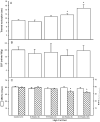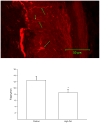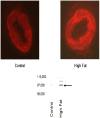Diet-induced obesity in Sprague-Dawley rats causes microvascular and neural dysfunction
- PMID: 20503263
- PMCID: PMC2878284
- DOI: 10.1002/dmrr.1088
Diet-induced obesity in Sprague-Dawley rats causes microvascular and neural dysfunction
Abstract
Background: The objective of this study was to determine the effect of diet-induced obesity (DIO) on microvascular and neural function.
Methods: Rats were fed a standard or high fat diet for up to 32 weeks. The following measurements were carried out: vasodilation in epineurial arterioles using videomicroscopy, endoneurial blood flow using hydrogen clearance, nerve conduction velocity using electrical stimulation, size-frequency distribution of myelinated fibres of the sciatic nerve, intraepidermal nerve fibre density using confocal microscopy and thermal nociception using the Hargreaves method.
Results: Rats fed a high fat diet for 32 weeks developed sensory neuropathy, as indicated by slowing of sensory nerve conduction velocity and thermal hypoalgesia. Motor nerve conduction velocity and endoneurial blood flow were not impaired. Mean axonal diameter of myelinated fibres of the sciatic nerve was unchanged in high fat-fed rats compared with that in control. Intraepidermal nerve fibre density was significantly reduced in high fat-fed rats. Vascular relaxation to acetylcholine and calcitonin gene-related peptide was decreased and expression of neutral endopeptidase (NEP) increased in epineurial arterioles of rats fed a high fat diet. In contrast, insulin-mediated vascular relaxation was increased in epineurial arterioles. NEP activity was significantly increased in the skin of the hindpaw. Markers of oxidative stress were increased in the aorta and serum of high fat-fed rats but not in epineurial arterioles.
Conclusion: Chronic obesity causes microvascular and neural dysfunction. This is associated with increased expression of NEP but not oxidative stress in epineurial arterioles. NEP degrades vasoactive peptides, which may explain the decrease in microvascular function.
Figures








Similar articles
-
Effect of inhibition of angiotensin converting enzyme and/or neutral endopeptidase on vascular and neural complications in high fat fed/low dose streptozotocin-diabetic rats.Eur J Pharmacol. 2012 Feb 29;677(1-3):180-7. doi: 10.1016/j.ejphar.2011.12.003. Epub 2011 Dec 14. Eur J Pharmacol. 2012. PMID: 22198047 Free PMC article.
-
Changes in endoneurial blood flow, motor nerve conduction velocity and vascular relaxation of epineurial arterioles of the sciatic nerve in ZDF-obese diabetic rats.Diabetes Metab Res Rev. 2002 Jan-Feb;18(1):49-56. doi: 10.1002/dmrr.257. Diabetes Metab Res Rev. 2002. PMID: 11921418
-
Effect of Treatment of Sprague Dawley Rats with AVE7688, Enalapril, or Candoxatril on Diet-Induced Obesity.J Obes. 2011;2011:686952. doi: 10.1155/2011/686952. Epub 2010 Aug 16. J Obes. 2011. PMID: 20847891 Free PMC article.
-
Effect of treatment of high fat fed/low dose streptozotocin-diabetic rats with Ilepatril on vascular and neural complications.Eur J Pharmacol. 2011 Oct 15;668(3):497-506. doi: 10.1016/j.ejphar.2011.07.016. Epub 2011 Jul 28. Eur J Pharmacol. 2011. PMID: 21816138 Free PMC article.
-
Vascular Impairment of Epineurial Arterioles of the Sciatic Nerve: Implications for Diabetic Peripheral Neuropathy.Rev Diabet Stud. 2015 Spring-Summer;12(1-2):13-28. doi: 10.1900/RDS.2015.12.13. Epub 2015 Aug 10. Rev Diabet Stud. 2015. PMID: 26676659 Free PMC article. Review.
Cited by
-
Modification of high saturated fat diet with n-3 polyunsaturated fat improves glucose intolerance and vascular dysfunction.Diabetes Obes Metab. 2013 Feb;15(2):144-52. doi: 10.1111/dom.12004. Epub 2012 Sep 30. Diabetes Obes Metab. 2013. PMID: 22950668 Free PMC article.
-
Characterization of diabetic neuropathy in the Zucker diabetic Sprague-Dawley rat: a new animal model for type 2 diabetes.J Diabetes Res. 2014;2014:714273. doi: 10.1155/2014/714273. Epub 2014 Oct 13. J Diabetes Res. 2014. PMID: 25371906 Free PMC article.
-
Enriching the diet with menhaden oil improves peripheral neuropathy in streptozotocin-induced type 1 diabetic rats.J Neurophysiol. 2015 Feb 1;113(3):701-8. doi: 10.1152/jn.00718.2014. Epub 2014 Nov 5. J Neurophysiol. 2015. PMID: 25376787 Free PMC article.
-
Rodent Models of Diabetic Neuropathy, Role of Calcium Homeostasis in Pain and KB-R7943 as a Potential Therapeutic.Int J Mol Sci. 2025 Feb 27;26(5):2094. doi: 10.3390/ijms26052094. Int J Mol Sci. 2025. PMID: 40076715 Free PMC article. Review.
-
High-fat diet-induced obesity Rat model: a comparison between Wistar and Sprague-Dawley Rat.Adipocyte. 2015 Jul 15;5(1):11-21. doi: 10.1080/21623945.2015.1061723. eCollection 2016 Jan-Mar. Adipocyte. 2015. PMID: 27144092 Free PMC article.
References
-
- Caglayan E, Blaschke F, Takata Y, Hsueh WA. Metabolic syndrome-interdependence of the cardiovascular and metabolic pathways. Curr Opin Pharmacol. 2005;5:135–142. - PubMed
-
- Costa LA, Canani LH, Lisboa HR, Tres GS, Gross JL. Aggregation of features of the metabolic syndrome is associated with increased prevalence of chronic complications in Type 2 diabetes. Diabetic Med. 2004;21:252–255. - PubMed
-
- de Jongh RT, Serne EH, IJzerman RG, de Vries G, Stehouwer SD. Impaired microvascular function in obesity: implications for obesity-associated microangiopathy, hypertension, and insulin resistance. Circulation. 2004;109:2529–2535. - PubMed
-
- Oltman CL, Coppey LJ, Gellett JS, Davidson EP, Lund DD, Yorek MA. Progression of vascular and neural dysfunction in sciatic nerves of Zucker Diabetic Fatty (ZDF) and Zucker rats. Am J Physiol. 2005;289:E113–122. - PubMed
-
- LeRoith D, Rayfield EJ. The benefits of tight glycemic control in type 2 diabetic mellitus. Clinical Cornerstone. 2007;8:S19–S29. - PubMed
Publication types
MeSH terms
Substances
Grants and funding
LinkOut - more resources
Full Text Sources
Medical

